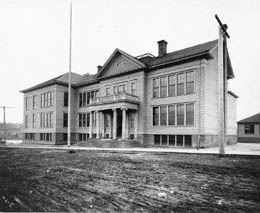In the fall of 1879, 10 years after the first homesteader arrived at Green Lake, a newly erected, simple log cabin schoolhouse opened its doors to 11 pupils near the corner of today's (1999) NE 56th Street and 25th Avenue NE. This was the first Green Lake School. (Green Lake, north of Seattle, was annexed to Seattle in 1891.) The children came from four households on the east side of the lake: seven were sons and daughters of the brothers W. L. and Robert Weedin. The pupils made their daily trek to school through dense timber along a crude wagon road. Thus began public school education in the territorial School District No. 25.
Wood's Contribution
By 1890, increasing numbers of residents with school age children were settling the Green Lake area, drawn in by promoter William D. Wood (1858-1917), owner of large tracts of land on the lake's eastern and northern shores. The need for a larger school soon became evident. Wood stepped forward and donated to the Seattle School District 10 lots from Block 99 in his Woodlawn Addition to Green Lake. The school board immediately accepted the generous offer and authorized construction of a two-room school house, not to exceed $1,500. That same year Seattle annexed most of the territory north of the ship canal, so the separate school districts in the towns of Fremont, Ross, and Green Lake were folded into Seattle School District No. 1.
Upon the opening of the school in 1891, 38 pupils assembled in the wood-frame building. In that first year only one of the rooms was used, but two years later enrollment reached 56, requiring that a second teacher be hired. The depression of 1893 slowed the settlement of the Green Lake area, but with the 1897 discovery of gold in Alaska, optimism returned to Seattle and new housing construction resumed. Soon the classrooms again bulged with too many pupils. A two room addition in 1898 alleviated the problem temporarily, but obviously new space would be needed soon. As a temporary measure to meet the growing needs of the 1,000 residents living nearby, in 1901 the school district opened two annexes at Green Lake. The first, about which little is known, was located on the site of the John Marshall school and provided space for two classrooms. The other occupied the two-story I.O.G.T. Hall at today's (1999) NE 72nd Street and 5th Avenue NE, above Baskin & Robbins. This temperance hall was home for three class rooms of second through fifth grade children during the 1901-02 school year.
Turn-of-the-Century Pupils
By the 1901-1902 school year, total enrollment at Green Lake school reached 445, more than 11 times the 1891 enrollment. Even as leases were being signed for the annexes, a new 12-room schoolhouse was in the planning. In the spring of 1901 the school district purchased seven lots adjacent to the school and let out a $38,000 contract based upon wood-frame architectural drawings of an architect hired two years earlier.
James Stephen developed plans and specifications for a Green Lake school that were soon adopted as the model for Seattle grammar schools planned by the school board throughout the next decade. His two-story designs enabled phased construction of buildings of eight, 12, or 20 rooms that could be expanded when needed.
The 1902-1903 school year opened with 570 first-through-eighth graders in the new 12-room wood frame building. A south wing was added in 1907 to accommodate a total of 912 pupils. Because construction of the Bagley school (1907), the Fairview school (1908), the Allen school addition (1912), and the F. A. McDonald school (1914) absorbed much of the growing population, this was the highest enrollment the Green Lake School ever reached.
Stephen's Green Lake school was razed in 1989 to make room for the more earthquake-proof, single-story school presently (1999) on the site. Examples of Stephen-designed schools survive throughout the city, however. Most closely resembling Green Lake school architecture is the Interlake school which, in recent years, was transformed by developers into the Wallingford Center, a complex of retail shops on the corner of N 45th Street and Wallingford Avenue in the Wallingford neighborhood of Seattle).

